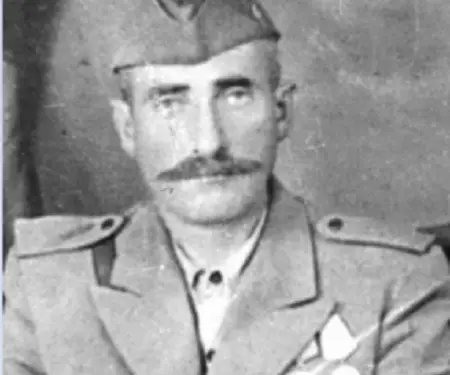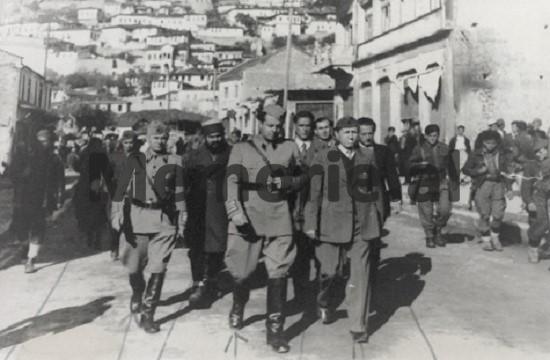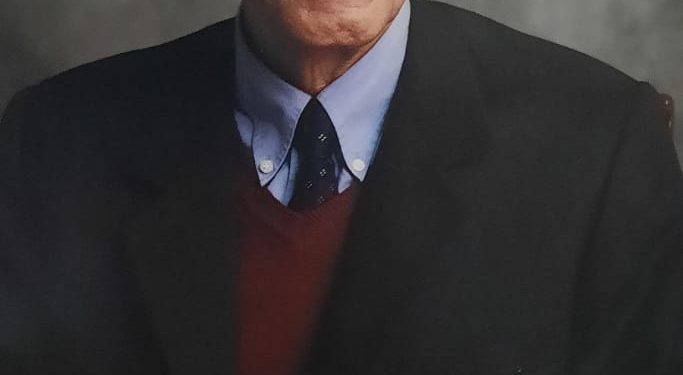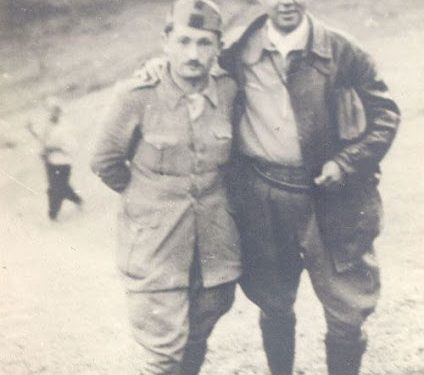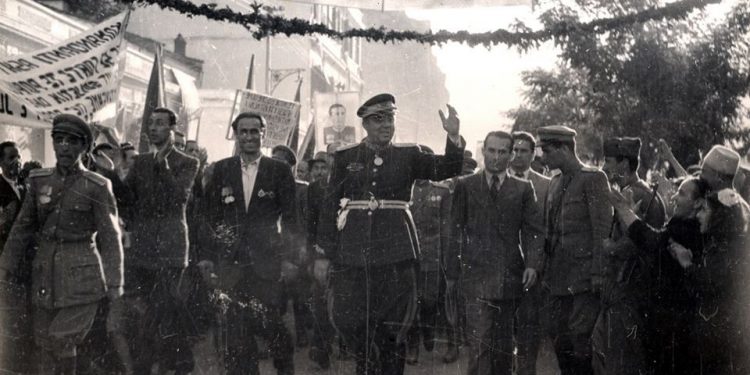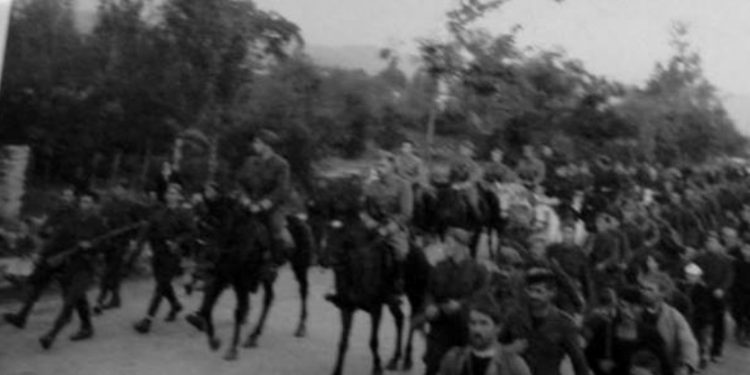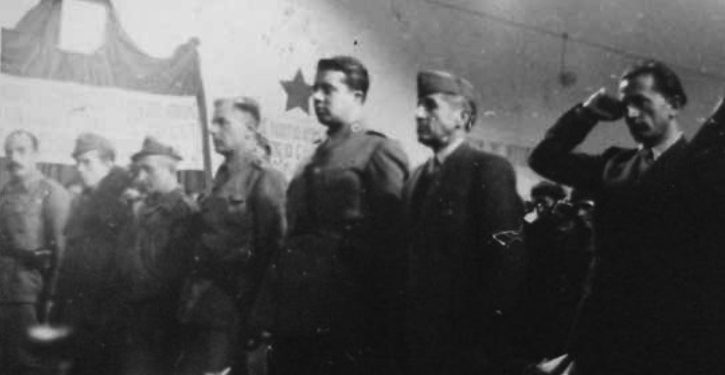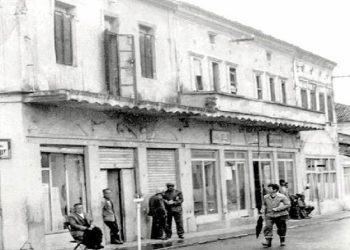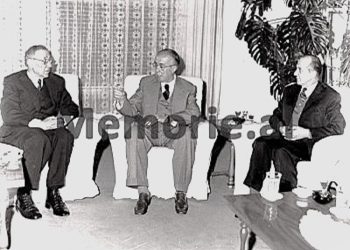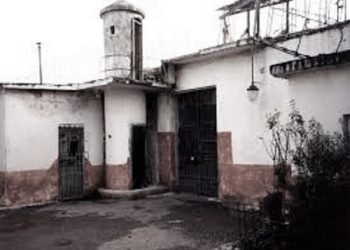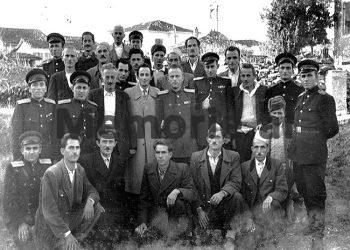By Elmas Guga
Memorie.al/ Causes of Enver Hoxha’s cruel behavior towards Mestan Ujanik and Gjin Marku. The truth of his policy during the war and after the liberation until 1948. Berat Plenum for the truth of this policy. Tito and Enver loved Albania for themselves and not for the Albanians who fought and sacrificed in World War II.
The region of Berat from the formation of the Albanian state and until 1948, when the regions merged as structures of local government, had under administration the districts of Berat, Skrapar, Lushnje, Fier and Mallakastër. According to the census of 1938, the region administered a territory of 3932 km with a population of 155 thousand inhabitants. It is worth bringing to the reader’s attention this data for each circle. Berat 61164 inhabitants and an area of 1134 km². Skrapar 20,207 inhabitants and 793 km². Lushnja 46420 inhabitants and an area of 835 km². Fier 17090 inhabitants and 490 km². Mallakastra 12190 inhabitants and 670 km².
Thus, during the fascist occupation and the LANÇ, this region ruled about 18 percent of the country’s population with about 14 percent of the territory. This administrative reality together with the data, facts and events that occurred during the fascism and war prove the truth that the region of Berat has been the promoter of the anti-fascist movement and LANÇ in Albania. Here we will bring some key moments in the development of the events of that period to prove the truth of that contribution, not necessarily to convince anyone who wants to manipulate the glory of our LANÇ, but to pave the way for our opinion of what we have provided in the title of this article.
The fascist invasion has been a great pain and wound for the whole people and the country. The pain was experienced with bright notes, especially in the region of Berat, distinguished for its spirit of patriotism and patriotism. For this we remind the reader that only from Tomorrica and Skrapar took up arms over 700 men and boys in the war of Vlora, organized in three battalions commanded by Servet Zaloshnja, Ali Koprencka and Riza Cerova. While Zenel Braçi and Xhemal Shtyllën commanded the fighters from Kolonja. I am sorry that I do not know how to say in numbers the fighters from Berat, Lushnja, Fieri and Mallakastra, however at the regional level they were over two thousand five hundred volunteers. In the war of Vlora, the region of Berat sent its men and boys not only with rifles in their arms and bags of bullets but also caravans of food. Suffice it to say that even the deep mountain Tomorrica sent to the command aid in cash, small cattle and bread grains.
The hatred and the smell of gunpowder that sowed that war felt fresh in those dark days of April 1939, to all the people of the Berat region. An expression of this deep pain was the elegy song written in Tomorrica on the day when the sky of Albania was blackened by the planes of the Duce. On that day, our poet Hekuran Zhiti, a teacher at the Zaloshnja school, would write:
Thirty-nine never come
That you dropped our flag
What flag that does not fly!?
I was hit rib by rib
Ever since they brought Italy.
You our ministers!
I forgot the money!
That you sold us the homeland.
The song together with the black news of the occupation spread like lightning in every village and house not only in Tomorrica and Skrapar but everywhere in the district of Berat. The anthem of the flag together with the song of the tomorricars would be sung in the mountains by the boys who fought for the freedom of Albania.
In the dark days of April, everywhere in the district of Berat, men and boys flooded the centers of the municipalities, protesting and demanding weapons, but returned disappointed and betrayed. This is how the Tomorricans suffered there in Konak, and some of them decided to go to Berat. Mestan Ujanik with 17 boys from Gjerbësi, Ujanik, Trebla, Shpatanji and Gradeci, on the second day were in front of the prefecture. Mestani with two of them were allegedly called to talk while they were isolated for several hours and the others were forcibly evicted. This was the power of the king hands up!
The spring-summer of 1939 quickly tasted the bitter taste of fascist occupation with a marked disruption of public order. The local authorities became more and more irresponsible people who endangered the lives and property of people everywhere in the Berat region. This category thought that with the help of “big brother” (Italy) they would become even more agallar than they were.
Innocent people were arrested and imprisoned. In August 1939, due to a false accusation, Mestan Ujaniku was released from prison with his eldest son Xhemali.
Newly released, he escapes to the mountains while his family of four sons are interned. Xhemali is imprisoned again. In the autumn of 1940 other regime rebels like Hajdër Krushova, Ferhat Gjonbabasi and Muharrem Trebla (Abazaj) joined Mestan Ujanik on the mountain. At this time Xhemali also escapes from prison and joins his father in the mountains. Thus, in the autumn of 1940, the nucleus was formed with 5 fighters, of what a little later, in January 1941, would be called Mestan Ujanik’s squad. Located on the front line of the Italian-Greek war, the region of Berat endangered the lives and property of the people. The desertions of boys from the army were daily problems as well as the refusal of recruits to perform military service.
The Skrapar sub-prefecture was almost paralyzed by mobilizing recruits. Mestan Ujanik’s gang consisted mainly of a contingent of boys as well as family members who had been caused family drama. In April 1941 the squad numbered 18 fighters. This was also the time when the squad began the first contacts with anti-fascist activists from the city of Berat. Soon the squad aspired for more law and justice, became the eye and ear of people who risked their lives and property. The platoon circulated throughout the county and had a good reputation among the people for helping people in the face of abusers in public life. Contacts and cooperation with anti-fascist activists from Berat (Kristo Isak, Mahmud Shehu, Tajar Grepca, Iljaz Sevrani, etc. since April 1941 increased its contribution to the people. Therefore, the good name of the gang was known everywhere in southern Albania. and beyond.
Its existence was known to the British in June 1941 as they tried to encourage the anti-fascist movement in Albania. From the first days of its establishment, the SNP prioritized political work in the Berat region because it had a nationalist gang that was respected by the people. Cooperation with Mestan Ujanik’s gang was the key to success, as it happened to increase the spirit of anti-fascism in the people of this region. Thus in 1941 this group for the deeds and good name of the people beyond the region of Berat and the political impact it carried to increase the spirit of anti-fascism in Albania marks the region of Berat as the number one among other regions of the country.
Gjin Marku, after performing some political and organizational tasks in the Peza gang in December 1941, started working in the region of Berat in the first days of January 1942. The main topic of his conversation with the communists and anti-fascists of the city of Berat was the meeting with Mestan Ujanik. The first meeting took place in late January in the village of Velabisht. In their efforts for cooperation, the second meeting was held in February 1942. The third meeting that finalized the formation of the Plaka Skrapar gang took place in the Kulmak Tekke on the night of March 13-14, 1942. In that meeting where all the squad was discussed and debated throughout that night. At dawn on March 14, the formation of the Plaka Skrapar gang with commander Mestan Ujaniku and Commissar Gjin Marku was announced.
Once legalized as a SNP combat formation, the squad expanded its vision for the tasks ahead. Even on March 14th there were numerous meetings with people coming to Tomorr for Summer Day. Worked with a plan every day. With the national flag flying and with songs in their mouths, the gangs marched to every village of Tomorrica, Skrapar and Opar, meeting people to join them in the fight against fascism. On May 9, in Bofje of Dushari, a meeting was held with communists and anti-fascists of the Korça region. While the activists of Korça were preparing for the formation of their squads, Mestani and Gjini gave their experience in the path of the fight for freedom. At the end of June, the second meeting took place in the same place, but already with the presence of 150 partisans of the Plaka gang, the Opar gang and the Mokra gang. They stayed there for about two weeks under the care of Maliq Dushari. In this place there was an idea and preparations were made for the national conference which was later held in Peze.
During August 1942, the squad had several meetings in the villages of Kolonjë, where it found maximum support for the war. There she increased her ranks with new fighters, of whom we can mention the partisan Baki Dume. These actions of the gang increased the tension of the fascist authorities in Tirana. Therefore, in the first days of August, Captain Xhaferr Bali was sent to Tomorrica at the head of 64 militias to give a good lesson to the gang and the Tomorricans. The newly returned detachment from Cologne prepared the siege plan of Xhaf Bali and surrounded it on the night of 30-31 August. The squad forced Xhafa to surrender with the entire militia. This action and the speeches of Mestan and Gjini were a great political and military capital that Mëlova conveyed to the people on the path to freedom.
Mëlova proved to the Albanians that they did not have too much blood to kill each other! Blood had to be spared to fight the Italian invader! The action encouraged the gang to prepare a war plan for the liberation of Çorovoda. The gang partisans and hundreds of volunteers surrounded Çorovoda on the night of September 4-5. On September 5, Çorovoda and the whole of Skrapar celebrated liberation from fascist occupation. Even on September 7 and 9, the Plaka squad and the freedom-loving people of Skrapar successfully withstood the fascist operations that flooded from Berat, Gramsh and Korça. The liberation of Skrapar on 5 September 1942 was announced as good news on Radio London on 6 September 1942.
The squad and its work would be a great political and military capital for the Peza Conference on September 16, 1942. At the end of September, the squad numbered over 160 partisans, so it was divided into 4 squads: The Old Squad with Commander Mestan Ujanik and Commissar Gjin Markun, Xhemal Ujanik’s squad and Commissar Xhavit Struga and squads with commanders Ramis Aranitas and Xhelal Staravecka.
In the autumn of 1942 the three Skrapar factions worked mainly to extinguish bloodshed and enmity in the spirit of the national platform of the Peza Conference. Meanwhile, Mestani and Gjini in November 1942 made an awareness tour in some provinces not only of Berat. They met with the leaders in Vërçë, Berat, Sulovë, Myzeqe and Mallakastër. In Berat the leaders, although skeptical, promised to cooperate to strike at the Italians in the city. In Myzeqe they found full support for the war.
In Mallakster, the leaders refused to cooperate because, according to them, the properties were damaged. They also met with Ali Këlcyra who refused to cooperate. When they returned to Berat on November 28, the Italians were moving around the city like snakes. They had received notice from the leaders (Balli at that time was not formed as a political organization). A spy was sent to kill Mestanini or Gjini in the hills of Kreka where the squad was located. The spy was deconstructed and took the bullet behind his neck. While an Italian plane was standing over the gang, Mestani hit him with his malignant and shot him down.
The plane crash had a major political effect not only within the country but also on the Allies. As it caused panic in the Italian authorities in Tirana. After that, the Gramsh sub-prefecture informed its superiors that Mestan Ujanik with 400 fighters would attack Gramsh. It was this drive that in December 1942, Major Halil Alia at the head of 250 militias (races) left for Tomorrica but came to Dobrenj and there received the announcement that he would not have the fate of Xhaf Bali. So, he returned and retaliated against Sotira.
The spirit of anti-fascism that planted the Plaka squad in the district of Berat during 1942 forced Mustafa Kruja to declare his resignation from Berat in December 1942.
I do not know of any other region that has excelled like Berat during 1942 in the mission of the war for the freedom of Albania.
In January 1943, the partisan forces of the regions of Berat, Korça and Gjirokastra, with coordinated actions, fought fiercely on the Kuqar-Përmet axis. At this time, it was also fought in Snosa and Kodovjat of Gramsh by the partisans of the detachments of Mokra, Gora-Opar and a partisan unit of Tomorrica commanded by Safet Vidhani. These fights raised the level of organization of partisan warfare.
In April 1943, the first partisan battalion of Myzeqe was formed with Rrahman Ruçi as commander, Commissar Muharrem Shabani and Major military inspector Spiro Moisiu. In June 1943, the partisan battalion “Riza Cerova” with commander Neshat Hysin was formed on Marta’s neck. On July 10, 1943, the General Staff of the Army was formed in Labinot with Major Commander Spiro Moisiu and Commissar Enver Hoxha. Local structures based on counties were also formed. Mestan Ujaniku, commander and commissioner Gjin Marku was elected for the Berat district headquarters.
The history of the war and the efforts of the partisan command of the Berat region is only a success story from the day of its formation as a structure of the war until October 22, 1944 when they were dissolved as such. Since the day of its formation in Vithkuq (August 25, 1943) the I S brigade had over 200 partisans from the Berat region. On September 4, the partisan command ordered the attack to defeat Isa Toska’s criminal gang. The entire local leadership took part in those fights. While Mestan Ujaniku led the operation at the head of 550 partisans. The defeat of the gang was a great political and military success for the Antifascist Front not only for the region. The people’s trust in the partisan war increased and they took up arms, tripling the district army.
On September 11, when German forces were 5 km away from Berat (Otllak), the partisan command ordered the attack for the (first) liberation of Berat. From that date until November 15, 1943 when it was occupied by the Germans, the city enjoyed temporary freedom. In other words, for two months Berat was a city-state, which is a unique case in Albania during the war. At that time, until September 25, the partisan command took over the food reserves and weapons left by the Italians. On September 19 in Ngurrëz the first partisan group of Myzeqe was formed with over 600 partisans and which included over 30 girls from Fier and Lushnja. The group commander was Rrahman Uruçi and commissioner Pipi Bakalli. Within September, three battalions were formed from the district of Berat and the second partisan group of the region (Shpirag Group) was formed with commander Vangjel Doga and Commissar Tajar Grepcka
Also ready were the 3 battalions of the third group of Skrapar with commander and commissar respectively, Zylyftar Veleshnja and Iljas Sevrani. The glory of this period is best appreciated by Kadri Cakrani as an opponent of the Front, – Whoever won Berat, at that time had won the south, and whoever won the south where the war took place had received the keys to victory.
This was done by Mestan Ujaniku and Gjin Marku with the commanders, commissars, partisans and the people of the Berat region. The region of Berat successfully withstood the German-ballistic operation of the winter of 1943-1944. The partisan forces of the district in Skrapar and Tomorrica were not only defended but also increased in number. In this enemy operation, the war in the Tent of the Cup has been legendary. On March 17, 1944 in Vlushë, the VII S brigade was formed with commander Gjin Markun. This brigade and other partisan formations of the district successfully withstood through fighting the German operation of June 1944, especially in the protection of the Berat-Përmet road. While Tomorrica ensured the success of Division I S in the legendary war of Tomorrica. After the June operation, the Berat region formed with its sons the X S Brigade in Karbunare with commander Njazi Çepani and in Therepel the XVI S Brigade with commander Rrahman Uruçi. The district partisan brigades liberated Kuçova and Fier. The liberation of Lushnja on October 18 marked the liberation of the entire region of Berat. To continue further for the liberation of Tirana, Mirdita, Lezha, Shkodra…
From April 1944 until the end, the General Staff and Enver Hoxha led the war in the region of Berat. In this district E. Hoxha felt safer than in the former Bloc where he ruled for 40 years. And for this the credit went to the people of this region and the partisan command with Mestan Ujanik at the helm.
On the above we do not exaggerate to say that the region of Berat has been the main contributor and locomotive of LANÇ in Albania. If we rightly say that LANÇ is the greatest work and the crown of glory of the Albanian people in all times, LANÇ in the region of Berat is the crown of glory for LANÇ nationwide. And if there are special names that gave glory to the region of Berat, during the war, they are Mestan Ujaniku and Gjin Marku. For everything they did for the good of the people and the freedom of Albania, great contributors of LANÇ.
In these circumstances, the question naturally arises: Why did Enver Hoxha behave so harshly to the point of cruelty with these two war captains?!
Mestan Ujanik was spared the suffering in the torture prison (15 May 1947-15 July 1948) in exchange for the disappearance of his bones leaving him without a grave! While Gjin Markut did not spare his suffering for decades in prison until he died in exchange for perhaps a grave! So, we ask again: Did E. Hoxha really want the success of LANÇ?! He wanted to follow in the footsteps of LANÇ’s success with the success of the fight to “pave the way” for his personal power. E. Hoxha chose to be at the head of the SNP for gaining personal power in a “free” Albania. While leading the successes of LANÇ, Mestani and Gjini for no moment or circumstance during the war, did not become soldiers of Enver Hoxha’s controversial policy in his struggle for power.
In Berat, not only the partisan command set the “border to thana” but also the plenum of the Central Committee of the SNP (November 23-27, 1944) put Enver behind the wall for his personal policy in the direction of the war. It was these circumstances that the Berat region was the great dilemma of Enver Hoxha in his struggle for power. Today there are dozens of interesting publications and publications of scholars and publicists passionate about historical truth. They are a sufficient source for any responsible person in this country to have and give his opinion on what happened to us during the war and the communist regime. I feel obliged to give such an opinion-analysis not only as a citizen of the region of Berat but also of my country to go to the end of the truth, not only for what happened in the region of Berat during the war and not only for two of its captains like Mestan Ujaniku and Gjin Marku.
As we pretend to do such a thing I cannot help but feel good that I have finally understood the essence of the thing about many things that happened during the war and after the liberation. In our journey to this analysis we are starting with the essence of the two opinions that have emerged from conversations with my friends. Since these opinions are shared by a large number of our public and readers, it is worth stopping at them.
The first opinion: “Do good to remove the mud from Mestan Ujanik and Gjin Marku, but do not throw it at others”! And they continue “Pity for what they have removed but… that was the time!” Their message is clear. They are worried that the figure of the “commander” will not be affected. The regret for the suffering of those who actually do honor to our nation and history, at the level of an insincere mercy, shows the low level of our public sensitivity to what happened to Albanians during the war and during the communist regime. The mud that covered Mestan and Gjini is actually a very small part of the giant mud that covered us all. It covered dozens of warlords and commissars who led partisan army formations. The mud-covered tens of thousands of partisans while others robbed us of the freedom gained through blood and sacrifice. That covered the entire General Staff that led that heroic war.
It covered thousands of prisoners and prison inmates. The mud that turned us all into slaves has raped our war history, which we are still unable to write today because we are held hostage by the “commander’s shadow”. That we continue to have a lame history of the national renaissance because of the “evil biographies” of some of those who made its history. The cause of this giant clay has not been man anyway but the first of the country for half a century.
Pointing the finger at him means understanding and separating truth from falsehood. It means appreciating the values and iniquities of our black past to illuminate the future.
Second opinion: “Do not criticize Enver too much because we risk damaging our LANÇ values!” Personally, my friend is more concerned with our LANÇ values than with Enver. However, those who share this opinion are more concerned about the figure of Enver. We must understand once and for all that the protection of the values of the war as a major act of the Albanian people cannot be done with “gloves” and Enver Hoxha must be protected as its leader. The cause of LANÇ as a work of the Albanian people has been something else with the cause of Enver. They are two parallels that have nothing in common./Memorie.al




